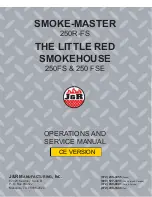
Cooking times & temperatures
The temperature settings and times given
in the baking guide are based on dishes
made with block margarine. If soft tub
margarine is used it may be necessary
to reduce the temperature setting.
If a recipe gives a different temperature
setting to that shown in the guide, the
recipe instruction should be followed.
The times given in the baking guide are
based on cooking in a preheated oven.
Aluminium foil
Use foil only to cover food or cooking
dishes, using foil to cover the shelves
or oven base creates a fire hazard.
16
Item
Temperature at ˚C
Approximate
Fanned
cooking time
(preheated oven)
Small cakes
175
15 - 25 mins
Whisked sponge
170
20 - 25 mins
Swiss Roll
190
10 - 12 mins
Victoria Sandwich
160
20 - 30 mins
(2 x 205mm / 8in)
Semi rich fruit cake
125
2
1
⁄
2
- 3 hours
(180mm / 7in)
Scones
210
10 - 15 mins
Meringues
90 - 100
2
1
⁄
2
- 3 hours
Shortcrust pastry
200
depending on size
Puff / Flaky pastry
210
& type of dish
Choux pastry
200
& type of filling
Biscuits
160 - 200
20 - 30 mins
Sponge pudding
150
45 mins - 1 hour
Milk pudding
150
1
1
⁄
2
- 1
3
⁄
4
hours
USING THE MAIN OVEN
Automatic cooking in the main oven
The automatic cooking facility is
controlled by the programmer (see
‘Programmer / Clock’ section) and allows
complete meals or individual dishes to
be cooked while you are out of the
house, to be ready for when you return.
The ‘
READY TIME
’ should be set as close
as possible to, or just after, your
anticipated return, so food is not left
standing in a warm oven.
Do
• Make sure that the oven lights are
switched off when leaving food in
the oven for a delayed start.
• Select foods which are as fresh as
possible, and as cold as possible - ie;
preferably straight from the refrigerator.
•
Choose foods which are suitable
for cooking from a cold start, as some
dishes will be affected by being
left uncooked, at room temperature,
perhaps for several hours - eg; a
wet filling on a pastry base.
•
Make sure that meat and poultry
are thoroughly thawed (but still cold
from the refrigerator) before placing
them in the oven, and avoid using
rolled joints of meat, which can be
more susceptible to the growth of
food poisoning organisms.
•
Cover dishes with lids or foil to keep
the food moist, and protect from
possible contamination; the food
can be uncovered towards the end
of cooking to crisp and brown.
Do not
•
Warm food should never be
placed in the oven if there is a
delay period.
•
Stews prepared by frying the
meat and vegetables first should
be cooked as soon as possible,
or refrigerated prior to placing in
the oven.
•
Some dishes are not suitable for
cooking on automatic - eg; dishes
containing left over meat or
poultry, dishes containing eggs,
cooked rice, or seafood.
•
Do not put food items (intended for
automatic cooking) into a warm
oven; allow the oven to cool before
setting for automatic cooking.
•
Do not over fill dishes containing
liquids, as they might boil over.
•
Never leave food in the oven to
cool slowly after cooking; serve
immediately or refrigerate.
•
Never use the automatic facility to
reheat ‘cook chill’ foods, as they
should go straight from the
refrigerator into a preheated oven.
21
USING THE OVENS



































